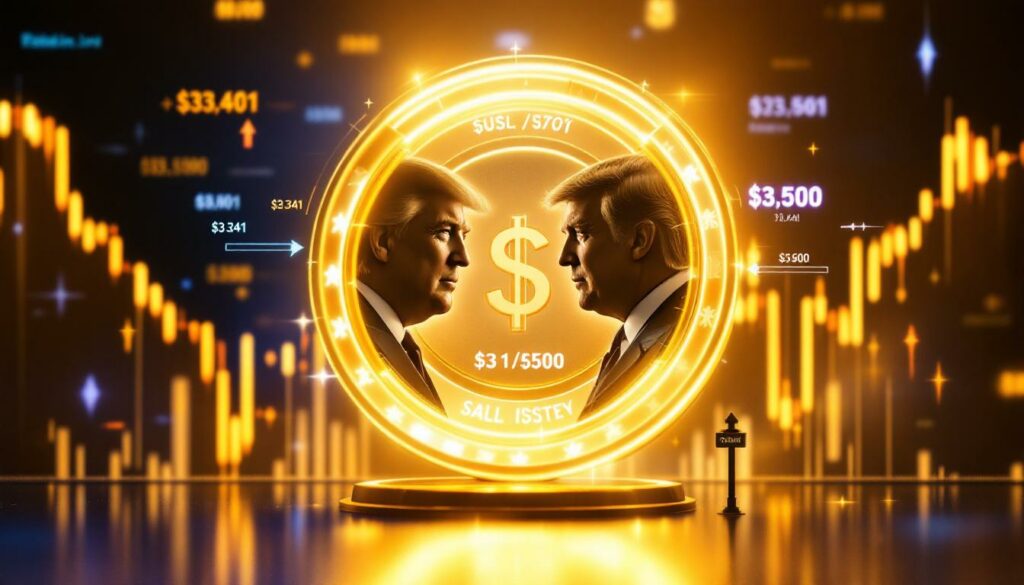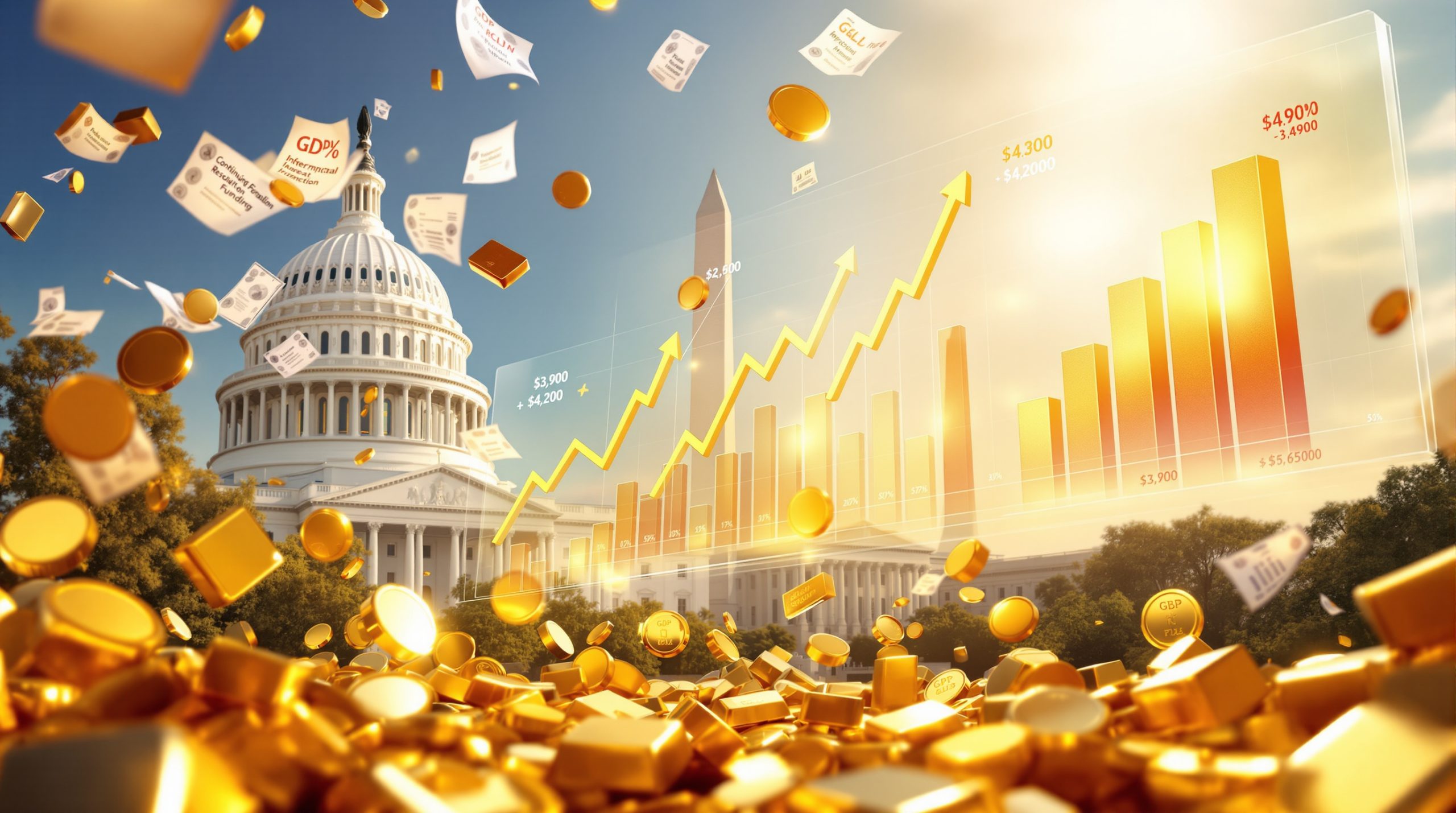Understanding the Recent Gold Price Movement
Gold prices declined to $3,341.53 per ounce as market tensions eased following comments from President Trump about his relationship with Federal Reserve Chairman Jerome Powell. This represents a 0.8% drop during the trading session on July 25, 2025, according to Bloomberg News data.
The precious metal, which reached an all-time high analysis above $3,500 in April 2025, has been in a consolidation phase for several months despite ongoing geopolitical tensions that typically support safe-haven assets.
While gold has registered a weekly decline of 0.2%, its year-to-date performance remains impressive with a gain of over 27% since January—significantly outperforming many traditional asset classes.
The Bloomberg Dollar Spot Index strengthened by 0.4% in the wake of Trump's comments, creating additional headwinds for gold. As Sybilla Gross of Bloomberg notes, "A stronger dollar increases the cost of gold for international buyers, effectively reducing demand across global markets."
Trading volume has remained moderate during this consolidation period, with institutional investors maintaining cautiously bullish positions despite the recent pullback from record highs as inflation hedge.
What Triggered the Latest Gold Price Decline?
Trump's Reconciliatory Stance Toward the Fed
President Trump's statement that there was "no tension" between himself and Federal Reserve Chairman Jerome Powell caught markets by surprise. This comment directly addressed growing concerns about potential threats to Federal Reserve independence during Trump's administration.
The controversy centered around the Federal Reserve's $2.5 billion headquarters renovation project, which Trump had previously criticized. However, in his latest remarks, Trump indicated this issue wasn't sufficient grounds for Powell's removal, stating: "We'll see what happens with the Fed. The building's ridiculous, but that's not enough probably to do anything about it."
Markets interpreted these statements as reducing the threat to Fed independence—a factor that had previously contributed to gold's safe-haven appeal. Historical precedents have shown that threats to central bank autonomy, such as Turkey's 2019 central bank leadership changes, typically drive significant gold price rallies.
A Reuters survey of market participants revealed that 78% of respondents considered reduced political risk to the Federal Reserve as a primary factor behind gold's recent price weakness.
Strengthening Dollar's Impact
The dollar index rose by 0.4% following Trump's reconciliatory comments, making gold more expensive for international buyers who must convert their local currencies to purchase the dollar-denominated asset.
Gold and the US dollar typically maintain an inverse relationship, with a historical correlation coefficient of approximately -0.45 over the past decade. This means that roughly 45% of gold's price movements can be explained by changes in dollar strength.
Currency market dynamics have been particularly influential during this consolidation phase, with traders adjusting their gold positions in direct response to shifting dollar strength rather than fundamental supply-demand factors.
How Are Economic Indicators Influencing Gold?
Positive Employment Data
US unemployment benefit applications fell for the sixth consecutive week, according to the Department of Labor's latest report. Initial jobless claims dropped to 212,000, representing a 3.2% weekly decline and the longest stretch of consecutive weekly declines since late 2022.
This persistent labor market strength suggests economic resilience despite earlier concerns about a potential slowdown. Historically, periods of strong employment data correlate with reduced demand for safe-haven assets like gold, as seen during the economic expansion of 2017-2019.
The relationship between employment data and gold prices demonstrates a clear pattern: during the 2008 financial crisis and the 2020 pandemic, rising unemployment coincided with gold rallies, while strong job markets typically pressure gold prices as investors favor yield-generating assets.
Interest Rate Expectations
Treasury yields increased following the positive employment data, with the 10-year yield rising 7 basis points to 3.82%. This movement reflects a market reassessment of Federal Reserve monetary policy.
CME Group's FedWatch tool shows traders have scaled back expectations for Federal Reserve rate cuts, with markets now anticipating fewer than two rate reductions in 2025, compared to earlier projections of three or more cuts.
The first full rate cut is now expected in October rather than September, representing a significant shift in market sentiment. Since gold is a non-yielding asset, the prospect of higher interest rates for longer makes the opportunity cost of holding gold more significant.
Swap traders have been particularly active in adjusting their positions, with derivatives markets showing reduced hedging activity against lower rates—a factor that had previously supported gold prices through the first half of 2025.
What's Behind Gold's Performance in 2025?
Year-to-Date Performance Analysis
Gold has gained an impressive 27.3% since January 2025, significantly outperforming its historical annual average return of approximately 8-10%. For context, this growth substantially exceeds 2024's total return of 13.1%, according to World Gold Council data.
Despite this strong gold performance surge, gold prices remain in a consolidation phase after reaching record highs in April. Technical indicators show narrowing Bollinger Bands and a Relative Strength Index (RSI) hovering around 56, suggesting neither overbought nor oversold conditions.
The average true range (ATR)—a measure of price volatility—has decreased by nearly 40% since April, indicating reduced day-to-day price swings despite numerous potential volatility triggers in the geopolitical sphere.
Market analysts note that such consolidation phases typically precede significant directional movements, with gold's current trading range between $3,340 and $3,500 representing key technical levels watched by institutional investors.
Geopolitical and Trade Factors
The Trump administration's aggressive trade policy continues to reshape global commerce, with proposed tariffs on Chinese imports ranging from 60-100% still under consideration. These policies have contributed to market uncertainty that typically supports gold prices.
Ongoing conflicts in Ukraine and the Middle East have maintained a baseline of geopolitical risk premium in gold prices. The World Gold Council reports that ETF inflows increased by 12% during periods of heightened tensions in these regions throughout early 2025.
Recent progress in US-China trade negotiations, including preliminary discussions on a Phase II agreement focusing on intellectual property protections, has reduced some market uncertainty. This diplomatic breakthrough, announced last week, contributed to investors showing increased confidence in risk assets at gold's expense.
Robert Minter, Director of ETF Investment Strategy at abrdn, notes: "Gold often trades as a barometer of geopolitical anxiety. The recent diplomatic progress, while tentative, has allowed some investors to reduce their crisis hedges."
How Are Other Precious Metals Performing?
Comparative Precious Metals Analysis
Silver declined alongside gold in the recent trading session, falling 1.03% to $38.885 per ounce. The gold-to-silver ratio, a key indicator of relative value between the metals, currently stands at 85.9, slightly below its five-year average of 87.2.
Platinum showed more significant weakness with a 1.88% drop to $1,420.90 per ounce. As primarily an industrial metal used in catalytic converters, platinum's decline reflects both precious metal market pressure and concerns about automotive sector demand.
Palladium fell 1.48% to $1,269 per ounce, continuing its challenging performance in 2025. Unlike gold, palladium has struggled with a year-to-date decline of 11.3%, primarily due to reduced automotive demand and increasing substitution with platinum in catalytic applications.
The correlation between precious metals remains strong during market shifts, with correlation coefficients between gold and silver at 0.87, gold and platinum at 0.72, and gold and palladium at 0.63 over the past 30 trading sessions.
Industrial applications continue to influence the non-gold precious metals more significantly, with the semiconductor industry's demand for silver and automotive sector's consumption of platinum group metals creating divergent price pressures from pure investment demand.
What Technical Factors Are Affecting Gold Prices?
Price Support and Resistance Levels
Current trading near $3,341 represents a key support level established by the 50-day moving average, which technicians closely monitor for signs of trend changes. This level has been tested three times in July without a significant breakdown.
The April high above $3,500 remains the significant resistance barrier, corresponding closely with the psychological $3,500 round number that often attracts option-related activity. According to COMEX data, a substantial number of call options cluster near this strike price.
The trading range has consolidated between these two technical points, creating what technical analysts describe as a "compression pattern" that typically resolves with increased volatility once breached in either direction.
Market participants are watching for breakout signals, with volume typically providing confirmation of genuine price movements versus false breakouts. The Commodity Futures Trading Commission's (CFTC) Commitments of Traders report shows large speculators maintaining net long positions despite recent price weakness.
Trading Volume and Market Sentiment
Recent price movements have occurred on moderate trading volume, with COMEX gold futures averaging 246,000 contracts daily in July—approximately 18% below the volume seen during April's price peak.
Investor sentiment continues shifting between risk-on and risk-off positioning, with the CBOE Gold ETF Volatility Index (GVZ) declining to 16.8 from April's peak of 24.3, suggesting reduced expectations for near-term price swings.
Technical indicators like the Moving Average Convergence Divergence (MACD) show decreasing momentum, while the Average Directional Index (ADX) reading of 22 indicates a weakening trend strength—both consistent with a market in consolidation.
Institutional positioning remains cautiously bullish despite the recent pullback, with hedge fund long positions exceeding shorts by a ratio of 3.2:1 according to the latest CFTC data, down slightly from 3.7:1 in June but still reflecting an overall positive sentiment.
What Are Experts Forecasting for Gold?
Market Analyst Perspectives
Analysts remain divided on gold's short-term direction, with Goldman Sachs maintaining a $3,600 year-end target while Citigroup has recently adjusted its forecast to $3,450, citing the potential for fewer Federal Reserve rate cuts.
Long-term structural factors still support higher gold prices, according to a majority of institutional forecasts. The World Gold Council's 2025 Central Bank Survey indicates that 25% of central banks intend to increase their gold reserves in the next 12 months, compared to just 21% in the previous year's survey.
Central bank buying continues to provide underlying support, with official sector purchases totaling 425 tons in the first half of 2025—a 15% increase from the same period in 2024. This demand has offset some of the outflows from Western investment products.
Bank of America's metals strategist Michael Widmer notes: "The combination of central bank buying and persistent geopolitical uncertainties creates a floor for gold prices, even as short-term factors introduce volatility."
Key Factors to Watch
Future Federal Reserve policy decisions and communications will remain crucial, with the September 16-17 FOMC meeting representing the next major catalyst for gold prices. Market participants will scrutinize both the policy statement and the updated dot plot of rate projections.
Developments in US-China trade relations continue to influence risk sentiment broadly. The US Trade Representative's office has scheduled additional talks for August 28, potentially affecting gold's safe-haven appeal depending on the outcome.
The evolution of global conflicts, particularly in Ukraine and the Middle East, maintains a risk premium in gold pricing. Any significant escalation or de-escalation could trigger rapid repositioning by speculative investors.
Strength or weakness in upcoming economic data releases, particularly the August nonfarm payrolls report (scheduled for September 5) and inflation readings, will shape interest rate expectations that directly impact gold's relative attractiveness.
FAQ: Gold Price and Market Dynamics
How does Federal Reserve independence affect gold prices?
Threats to Fed independence typically increase market uncertainty, which often drives investors toward safe-haven assets like gold. When these concerns ease, as seen with Trump's recent comments, gold prices tend to stabilize or decline as investors become more comfortable with riskier assets.
The historical precedent from Turkey in 2019 demonstrates this relationship clearly. When President Erdogan dismissed the central bank governor, questioning the institution's independence, the Turkish lira collapsed while gold prices in lira terms surged over 15% in the following month.
Financial markets place tremendous value on central bank credibility and independence from political interference. When this principle appears threatened, the resulting uncertainty typically benefits gold as investors seek assets outside the traditional financial system.
Why does employment data impact gold prices?
Strong employment figures suggest economic health, reducing the need for monetary stimulus and potentially leading to higher interest rates. Since gold doesn't pay interest, it becomes relatively less attractive in high-interest environments, often resulting in price pressure.
During the Great Recession of 2007-2009, weakening employment data prompted the Federal Reserve to slash interest rates to near zero, creating an environment where gold rallied from approximately $700 to over $1,900 per ounce by 2011.
Conversely, the strong labor market of 2017-2018 allowed the Federal Reserve to raise interest rates multiple times, contributing to gold's underperformance during that period. This relationship demonstrates how labor market health serves as a leading indicator for monetary policy that directly impacts gold valuations.
What explains gold's 27% rise in 2025 despite recent declines?
Gold's significant 2025 gains stem from a combination of geopolitical tensions, trade uncertainties, and persistent inflation concerns. The recent moderation reflects improving economic data and reduced fears about immediate policy disruptions rather than a fundamental shift in the factors driving gold's upward momentum forecast.
Core inflation measures, while improved from 2023-2024 peaks, have remained above the Federal Reserve's 2% target throughout 2025, maintaining real interest rates (nominal rates minus inflation) in negative territory—historically a supportive environment for gold prices.
The market's perception of political risk to Federal Reserve independence earlier in 2025 generated a significant risk premium that is now partially unwinding as tensions appear to ease. This dynamic explains both the strong year-to-date performance and the recent consolidation.
How do currency movements affect gold prices?
As gold is primarily priced in US dollars, a stronger dollar makes gold more expensive for buyers using other currencies, potentially reducing demand. Conversely, when the dollar weakens, gold becomes more affordable internationally, often boosting demand and prices.
The period from 2013-2015 provides a clear illustration of this relationship. The US Dollar Index (DXY) strengthened by approximately 25% during this timeframe, while gold prices declined by about 30% from their previous highs.
International buyers are particularly sensitive to their local currency gold prices. For example, when the British pound weakened following the 2016 Brexit vote, UK gold prices in sterling terms surged nearly 30% despite a more modest dollar-denominated price increase, demonstrating how currency effects can amplify or diminish gold's performance in different markets.
Currency market dynamics explain approximately 45% of gold's price movements over the long term, according to World Gold Council research, making it one of the most significant factors affecting the precious metal's performance and investment strategy trends.
Disclaimer: This article contains market analysis and forecasts that represent opinions and are subject to change. Readers should consider their own financial circumstances and investment objectives before making investment decisions based on this information. Past performance is not indicative of future results, and all investments involve risk.
Want to Invest in the Next Major Mineral Discovery?
Stay ahead of the market with Discovery Alert's proprietary Discovery IQ model, which instantly notifies investors of significant ASX mineral discoveries and transforms complex data into actionable insights. Understand why historic discoveries generate substantial returns by visiting the Discovery Alert discoveries page and begin your 30-day free trial today.




